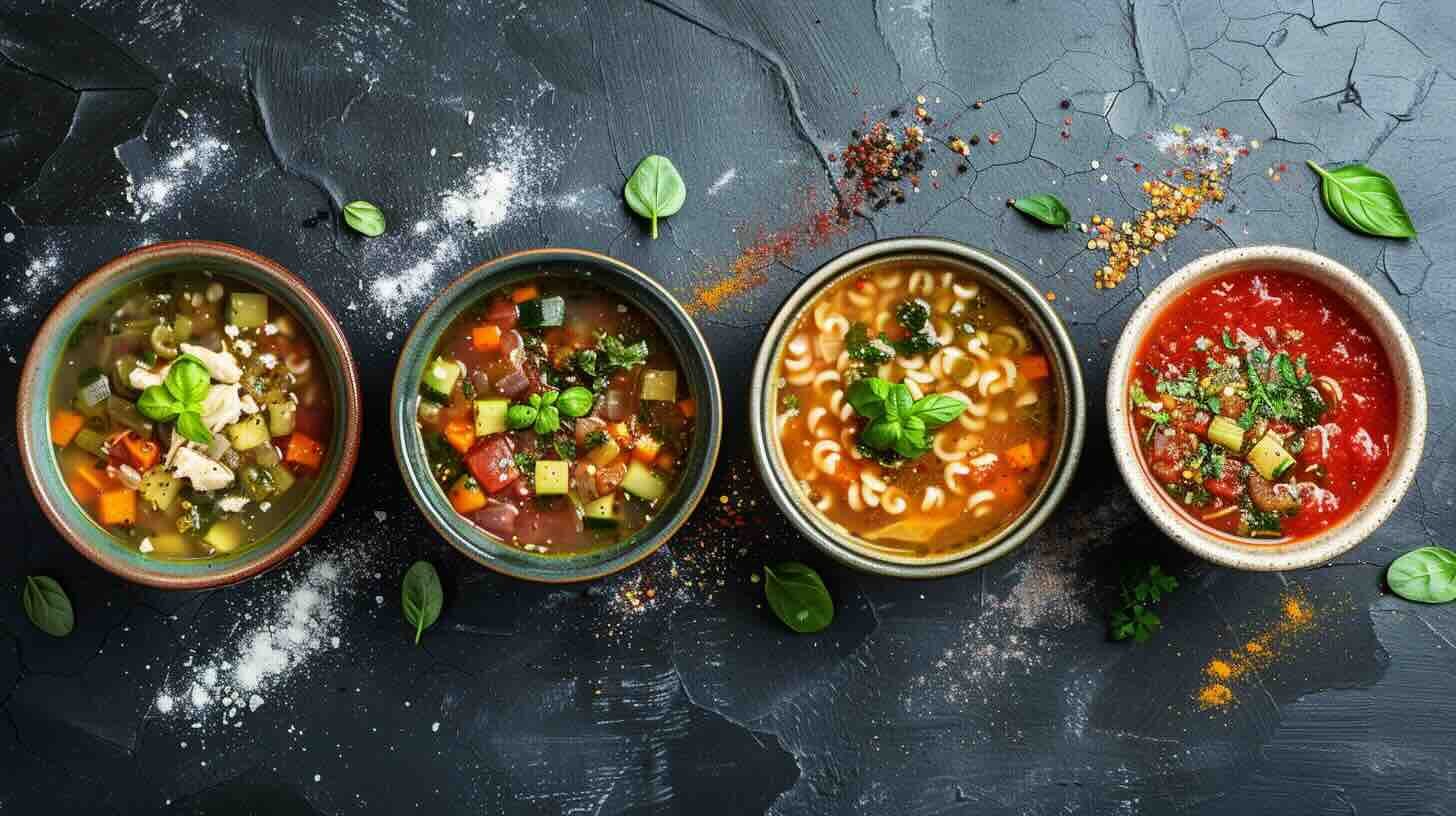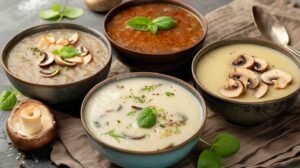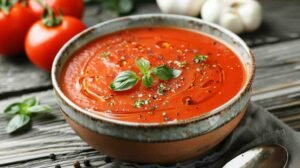Healthy Minestrone Soup Recipes
Minestrone soup, a traditional Italian dish, is lauded for its wholesome and satiating qualities. It combines an array of vegetables, beans, and pasta in a savory broth, making it a nutritious option for those seeking comfort in a bowl. Below are two minestrone soup recipes tailored for health-conscious individuals.
Classic Minestrone Soup Recipe

The classic minestrone soup is a medley of fresh vegetables and legumes, simmered in a richly seasoned broth. To craft this version, the following ingredients are typically employed (Quora):
- Olive oil
- Onion
- Garlic
- Carrots
- Celery
- Zucchini
- Green beans
- Diced tomatoes
- Vegetable broth
- Kidney beans
- Cannellini beans
- Oregano
- Basil
- Thyme
- Salt and pepper
- Small pasta (like ditalini)
- Greens (spinach or kale)
- Grated Parmesan cheese (optional)
- Fresh basil leaves for garnish
Begin by sautéing onions, garlic, carrots, and celery in olive oil until softened. Add zucchini, green beans, tomatoes, and broth, bringing the mixture to a simmer. Introduce the beans and pasta, cooking until tender. Stir in the herbs and greens, adjusting seasoning to taste. Serve topped with Parmesan and fresh basil.
For a comprehensive guide on preparing this classic dish, explore our collection of healthy soup recipes.
Vegetarian Minestrone Soup Recipe
Vegetarian minestrone embraces the same foundational elements as the classic version but can be customized to exclude pasta or rice for a lighter variant. Ingredients for a simple vegetarian minestrone are as follows (Quora):
- Olive oil
- Onion
- Carrots
- Celery
- Garlic
- Zucchini
- Yellow squash
- Diced tomatoes
- Kidney beans
- Cannellini beans
- Dried herbs (like oregano and basil)
- Vegetable broth
- Greens (like spinach or kale)
- Grated Parmesan cheese (optional, for serving)
In this version, start by heating olive oil and cooking the onion, carrots, celery, and garlic. Add zucchini, squash, tomatoes, beans, and herbs, then pour in the broth. Simmer until the vegetables are tender. Before serving, stir in the greens, and once wilted, serve hot, garnished with Parmesan if desired.
To discover more vegetarian options, delve into our vegetarian soup recipes, each promising robust flavors and hearty textures.
Both the classic and vegetarian minestrone soup recipes can be personalized by incorporating various vegetables and seasonings based on individual tastes. Whether you opt for the traditional recipe or the vegetarian variant, minestrone soup is a delightful way to enjoy a range of nutritious ingredients in one dish.
Ingredients for Minestrone Soup
Minestrone soup is a versatile and nutritious dish that can be adapted to suit any season or preference. The foundation of a delicious minestrone soup lies in its ingredients. Here we explore the common vegetables and pasta or grain options that go into making this beloved Italian soup.
Common Vegetables in Minestrone
Minestrone soup traditionally includes a variety of vegetables, which can change depending on the season. It’s important to use fresh vegetables to ensure the soup has the most flavor and nutritional value (Italian Food Forever).
Here is a list of common vegetables found in minestrone soup recipes:
- Onions
- Carrots
- Celery
- Tomatoes
- Green beans
- Zucchini
- Summer squash
- Spinach or chard
- Pumpkin (in fall recipes)
Each vegetable contributes to the soup’s hearty texture and rich flavors. For example, onions, carrots, and celery provide a flavor base, while tomatoes offer a tangy contrast. The addition of green beans, zucchini, and summer squash can give the soup a fresh, summery feel, while pumpkin and chard can make it more suitable for cooler seasons.
Pasta and Grain Options
The choice of pasta or grains in minestrone soup can greatly influence its texture and substance. Regional variations in Italy reflect the diverse use of these ingredients, with rice often used as a thickener in northern regions like Piedmont, bread in Tuscany, and pasta in southern regions.
Common pasta and grain options include:
- Ditalini or small shell pasta
- Elbow macaroni
- Rice
- Farro
- Orzo
The pasta or grains absorb the flavors of the broth and vegetables, adding a comforting and filling component to the soup. When selecting pasta or grains, consider how they will complement the other ingredients and the desired consistency of the soup.
For more inspiration on healthy and hearty soup options, explore our collection of healthy soup recipes, including vegetarian soup recipes, and learn how to incorporate a variety of vegetables and grains into your cooking repertoire.
Seasoning and Flavoring Minestrone
Seasoning is an essential component in creating a sumptuous bowl of minestrone soup. With the right combination of herbs and spices, one can transform a simple vegetable broth into a flavorful and aromatic delight.
Herbs and Spices for Minestrone

The key to a flavorful minestrone lies in the use of dried herbs and spices that are traditionally associated with Italian cuisine. Here’s a list of some popular seasonings used in minestrone soup recipes:
- Basil
- Oregano
- Garlic powder
- Onion powder
- Paprika
- Red pepper flakes
- Italian seasoning
- Bay leaf
These herbs and spices can be adjusted in quantity according to personal preference to create a rich and savory soup base. Additionally, garnishing with fresh herbs such as basil, oregano, and parsley adds a burst of color and enhances the soup’s freshness (Divas Can Cook).
Customizing Minestrone Flavors
To customize the flavor profile of your minestrone soup, consider the regional variations and local customs. In Liguria, for instance, the use of fresh herbs is paramount, while in southern regions, parmesan or pork rind may be used to enrich the soup’s flavor (Italian Food Forever).
For those preparing a plant-based minestrone, it’s advisable to focus on using fresh, seasonal vegetables and to avoid overcooking them to preserve their texture and vibrant colors. Incorporating pasta or rice towards the end of cooking ensures they remain al dente and not mushy. Seasonings should be adjusted to taste, taking care not to overpower the natural flavors of the vegetables (Dr. Siri Chand).
A classic minestrone soup often includes a tomato broth flavored with herbs, starchy beans, and pasta, and is typically topped with fresh parsley and Parmesan cheese. This hearty soup is perfectly complemented by a serving of crusty bread, making it a light yet satisfying meal.
When preparing minestrone, consider the diversity of vegetable soup recipes or even look into vegetarian soup recipes for inspiration on how to incorporate various vegetables and herbs into your soup. Whether you are a fan of broccoli soup recipes or carrot soup recipes, you can apply similar techniques to your minestrone for a personalized touch. Remember, the best minestrone soup recipes are the ones that suit your palate while providing a comforting and nutritious experience.
Cooking Methods for Minestrone
The process of cooking minestrone soup can be as varied as its ingredients, with techniques ranging from time-honored traditional methods to quick and convenient modern approaches. Here, we outline how to prepare this versatile soup to suit any schedule or preference.
Traditional Cooking Techniques
Traditionally, minestrone is cooked slowly, allowing the flavors of the various vegetables, proteins, and starches to meld harmoniously. This method requires layering the flavors by:
- Sautéing aromatics such as onions, garlic, carrots, and celery.
- Adding broth, tomatoes, and harder vegetables that require longer cooking times.
- Simmering until the vegetables are just tender.
- Incorporating quick-cooking ingredients like zucchini and green beans towards the end.
- Stirring in starches, such as pasta or rice, and cooking until al dente.
- Finishing with a swirl of extra virgin olive oil or a sprinkle of Parmesan cheese.
Each region in Italy has its own take on this classic dish; for example, rice is used as a thickener in the northern regions like Piedmont, while pasta is common in the south (Italian Food Forever). Cooking minestrone traditionally allows for personalization and adaptation to available local and seasonal produce.
Quick and Easy One-Pot Methods
For those with a busier lifestyle, minestrone can be prepared using a one-pot method for a satisfying meal without the lengthy preparation. The key steps for this method include:
- Utilizing a large pot to sauté the aromatics.
- Pouring in the broth and bringing it to a boil.
- Adding all the vegetables and proteins, considering the cooking time of each to ensure even doneness.
- Introducing pasta or grains later in the cooking process to avoid overcooking.
- Adjusting the seasoning and serving hot.
This Gluten-Free Minestrone Soup, for instance, is a versatile recipe that adapts well to a one-pot method, allowing for a mix of different veggies and herbs tailored to personal taste. It is simple to prepare, ideal for quick lunches or dinners, and perfect for freezing.
| Cooking Method | Time Required | Complexity | Flavor Development |
|---|---|---|---|
| Traditional | Longer | Moderate | Rich and Deep |
| One-Pot | Shorter | Easy | Balanced and Satisfying |
In either method, remember not to overcook the vegetables to maintain texture and vibrant colors, and adjust seasonings as needed for the best results. Whether you choose the slow-cooked richness of traditional techniques or the swift simplicity of the one-pot method, minestrone promises a nourishing and flavorful meal. Explore other healthy soup recipes for more inspiration on wholesome and delicious soup options.
Serving and Enjoying Minestrone
Minestrone soup, with its rich and vibrant flavors, is a delight to serve and enjoy. Whether it’s a hearty meal or a light appetizer, the way you garnish and pair minestrone can enhance the dining experience.
Garnishes and Toppings
A bowl of minestrone is not just about the soup itself but also about the garnishes and toppings that add texture and flavor. According to Love and Lemons, common toppings include freshly grated Parmesan cheese, a sprinkle of chopped parsley, and a drizzle of high-quality olive oil. Here’s a simple list of garnish options to elevate your minestrone:
- Freshly grated Parmesan cheese
- Chopped fresh parsley or basil
- A drizzle of extra virgin olive oil
- Cracked black pepper or red pepper flakes for heat
- A dollop of pesto for a herbaceous kick
Each of these toppings can add a unique taste and aroma to the soup, complementing the herb-flecked tomato broth and the mix of vegetables within.
Pairing Minestrone with Sides
Minestrone is a versatile dish that pairs well with a variety of sides. For a classic combination, serve it with crusty bread to soak up the flavorful broth. The soup’s light yet satisfying nature makes it an excellent partner to a crisp green salad dressed with a simple vinaigrette.
For those looking for a more substantial meal, consider pairing minestrone with a protein-rich side, such as grilled chicken from our chicken soup recipes collection. Alternatively, for a fully plant-based meal, you could pair it with a quinoa or farro salad from our vegetarian soup recipes.
Here are some side dish ideas to serve with minestrone:
- Crusty bread or garlic bread
- A green salad with vinaigrette
- Grilled chicken or fish
- Quinoa, farro, or another hearty grain salad
- A slice of frittata or quiche
When planning your meal, consider the flavors in your minestrone and choose sides that will complement or contrast them for a well-rounded dining experience. The key is to balance the richness of the soup with the lightness of the sides, creating a satisfying meal that is both delicious and nourishing.
Remember, minestrone is a dish that embodies comfort and versatility. Whether you choose to enjoy it as a standalone meal or paired with sides, it’s a bowl of goodness that never fails to please. Explore our extensive collection of healthy soup recipes for more inspiration on creating and pairing your perfect bowl of minestrone.
Health Benefits of Minestrone
Minestrone soup is not just a comforting and hearty dish; it’s also a powerhouse of nutrition. With a medley of fresh vegetables, legumes, and grains, minestrone soup recipes are a smart choice for those looking to bolster their health. Let’s delve into the nutritional benefits and how minestrone can play a role in weight management.
Nutritional Value of Minestrone
Minestrone soup is a celebration of vegetables and, as such, is packed with essential vitamins, minerals, and fiber. The plant-based nature of vegetarian soup recipes, like minestrone, makes it a fantastic option for those following a vegan or vegetarian diet, offering a rich variety of nutrients that are crucial for maintaining good health.
According to Dr. Siri Chand, a vegan version of this soup is low in calories and fat, which benefits long-term health maintenance. Moreover, the soup’s high antioxidant content from the array of fresh veggies, legumes, and herbs helps combat inflammation, promoting overall wellness.
For those with specific dietary requirements, gluten-free minestrone soup options are gentle on the digestive system, omitting animal products and gluten, which can be beneficial for those fighting chronic illnesses or managing food sensitivities.
Minestrone for Weight Management
Minestrone soup’s high fiber content, derived from its vegetable and pasta ingredients, contributes to a feeling of fullness without a high calorie count. This makes it an excellent dish for those looking to manage their weight. The soup can be customized to non-spicy preferences or fortified with more vegetables to suit individual tastes while maintaining its low-calorie profile.
A bowl of minestrone provides a satisfying and nutrient-dense meal, making it easier to avoid less healthy options and stick to a balanced diet. It is especially welcoming on colder days, offering warmth and nutrition in one bowl (Garnish & Glaze).
For those seeking additional healthy soup options that offer similar benefits, exploring healthy soup recipes like lentil soup recipes, carrot soup recipes, and broccoli soup recipes can further diversify your diet while keeping health and wellness at the forefront.



